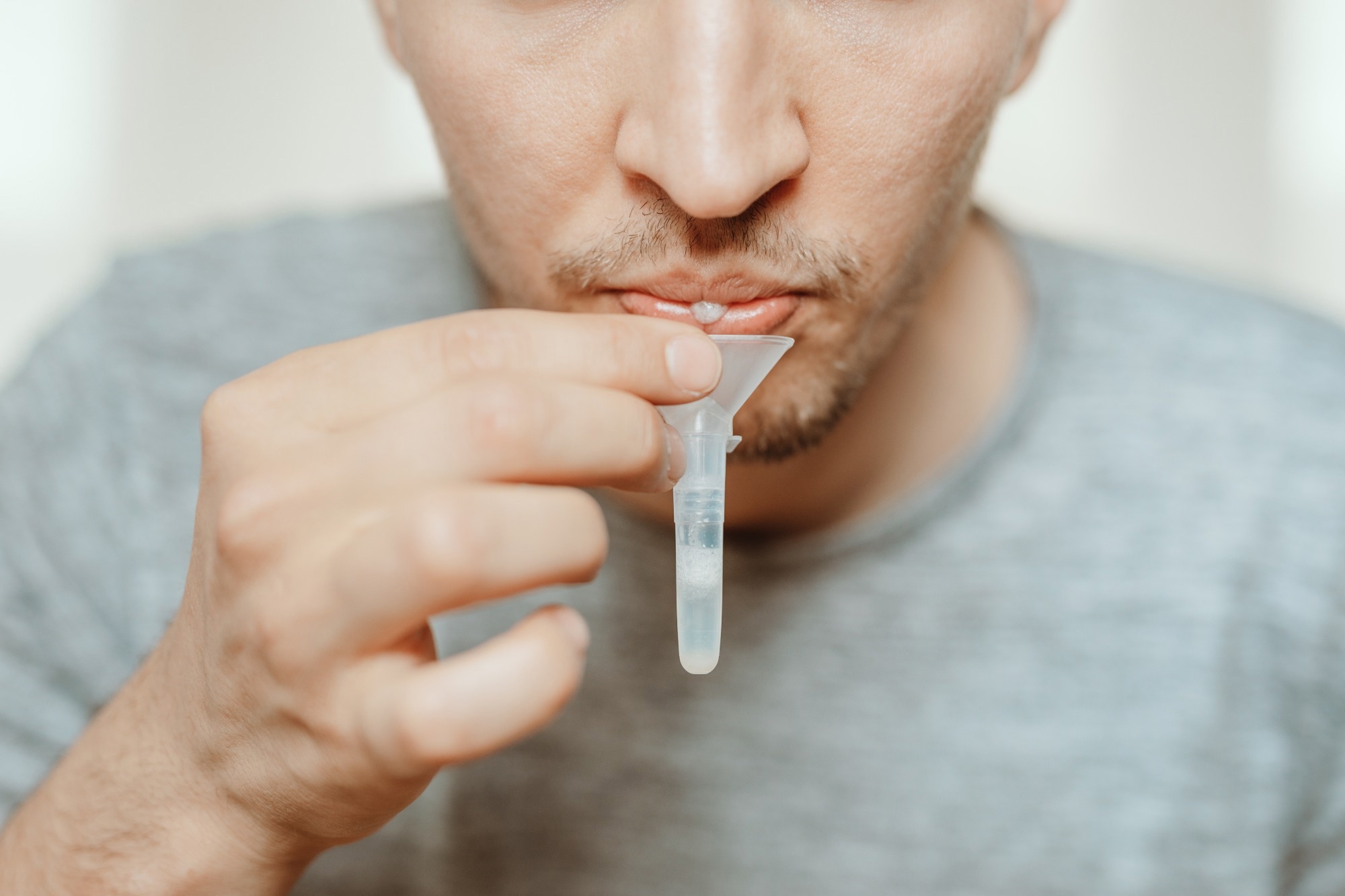In a recent study published in the PLOS ONE journal, researchers at Rutgers New Jersey Medical School explored the persistence of severe acute respiratory syndrome coronavirus 2 (SARS-CoV-2) in human saliva.
Accurate and rapid SARS-CoV-2 infection diagnosis has proven to be critical in coronavirus disease 2019 (COVID-19) management. Salivary and nasal swabs are some popularly employed non-invasive methods for testing infection with minimal to no supervision, thus enabling the widespread activity of COVID-19 testing. Several studies performed on nasal and pharyngeal samples noted a reduction in viral shedding along with a decline in culturable virus within the first week of COVID-19 symptoms. However, only a few studies have assessed the duration for which SARS-CoV-2 is detected in salivary samples in comparison to nasal swabs after the initial week of symptoms.
 Study: Persistence of SARS-CoV-2 in saliva: Implications for late-stage diagnosis and infectious duration. Image Credit: Shotmedia / Shutterstock
Study: Persistence of SARS-CoV-2 in saliva: Implications for late-stage diagnosis and infectious duration. Image Credit: Shotmedia / Shutterstock
About the study
In the present study, researchers examined whether salivary testing detected the prolonged presence of SARS-CoV-2 and related potential infectiousness.
The team compared viral load dynamics associated with salivary and nasal specimens by performing a substudy in an observational group study of therapeutic and diagnostic techniques among COVID-19 patients. Eligible participants were patients who were enrolled at University Hospital, New Jersey. These participants were aged 18 years or older and tested SARS-CoV-2-positive by a nasopharyngeal (NP) swab and consented to provide nasal and saliva samples.
Participants who were to be treated for COVID-19 during their course of hospitalization were monitored. The substudy involved all the participants from the parent study who provided a known duration since symptom onset and a nasal as well as a saliva sample for a minimum of one study time point. All eligible participants were a part of the overall assessment, which involved paired saliva-nasal swab analysis referenced to the time of COVID-19 symptom onset. The study collected specimens like self-collect saliva, anterior nasal swabs, and NP swabs.
Results
From June 2020 to August 2021, a total of 140 participants were recruited in the study, among which 44 persons were excluded. Among the remaining 96 patients, approximately 147 nasal and saliva swabs were assessed as paired observations across the overall study. Out of these 96 participants from the overall analysis group, 28 participants having over one-time point collection were eligible for the longitudinal analysis.
Among 96 participants from the overall analysis group, the mean patient age was 54.7 years, including 53% male and 55% Hispanic persons. The average baseline sample collection occurred seven days post-symptom onset. A majority of the participants reported a minimum of one comorbidity, such as obesity or hypertension, were exposed to another person having SARS-CoV-2 symptoms or required supplemental oxygen during their hospital stay.
Important time intervals in the study were over five days, representing the least recommended isolation period for SARS-CoV-2, and over nine days when patients were considered to be no longer SARS-CoV-2 infectious because of a lack of culturable virus in nasal or NP specimens. The team noted that dyspnea was more common among the five to nine-day and 10-14 day interval cohorts, while all other symptoms were comparable between the cohorts. Patients were more likely to need oxygen support in the later periods than patients in earlier periods. Furthermore, the participants who were recruited less than five days after symptom onset had a higher likelihood of being Black, smokers, and had a higher incidence of chronic kidney disease.
The overall assessment revealed that saliva testing detected remarkably more SARS-CoV-2 infections within five days, beyond five days, beyond nine days, and beyond 14 days of SARS-CoV-2 symptoms. Additionally, overall median N2-target Ct values were found to be earlier for salivary than for nasal samples. Also, Ct values were earlier for salivary than for nasal specimens for all time periods, including those after 14 days of symptoms.
Rates of SARS-CoV-2 positivity after five days since symptom onset were comparable between salivary samples and NP swabs. Also, overall Ct values were not remarkably varied between NP viral transport medium (VTM) swabs and direct saliva samples. Additionally, no variation in median Ct values or in the number of tests that yielded Ct values under 30 was noted between saliva samples and NP swabs for all assessed time periods.
Conclusion
The study findings highlighted the evidence for the detection of prolonged presence of SARS-CoV-2 in salivary samples in comparison to nasal specimens after the initial week of symptom onset, including propagating virus. The researchers believe that these findings supported the inclusion of salivary testing in the later periods of the disease course to improve the yield of SARS-CoV-2 diagnosis and the potential of a prolonged oral infectious duration in allowing the detection of saliva-based assessment in individuals with COVID-19 diagnosis.